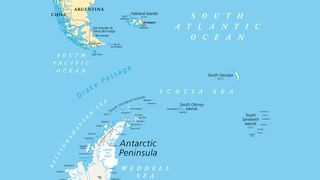Have you ever come across videos online showcasing a stark line dividing the ocean, with seemingly different waters side by side, and claiming it’s the unmixable boundary of the Atlantic and Pacific Oceans? These viral clips often suggest that these two massive bodies of water remain separate, but is there any truth to this claim?
The notion of unmixed oceans is captivating, yet fundamentally inaccurate. The reality, as oceanographer Nadín Ramírez from the University of Concepción in Chile explains, is quite the opposite: “The short answer is yes! The waters are constantly mixing.” While dramatic lines in the ocean can occur, they are typically due to factors like river runoff or glacial melt, not a permanent separation between the Atlantic and Pacific. Let’s dive into the science behind where the Atlantic and Pacific Oceans truly meet and how their waters interact.
Imagine pouring cream into your coffee and watching it swirl and gradually blend. This visual offers a simplified analogy to ocean mixing. When you see a distinct line in the ocean, it often indicates a zone where waters with different properties – such as temperature, salinity, or density – are in contact. Like the cream in coffee, these waters will eventually mix, but the process can take time, especially when the differences are significant.
Factors such as strong winds and powerful waves act like a vigorous stir to our coffee analogy, accelerating the mixing process considerably. These forces generate turbulence, breaking down the boundaries between water masses and promoting a more rapid integration.
The area where the Pacific and Atlantic Oceans predominantly meet is around the southern tip of South America. Here, the continent fragments into a series of islands, creating complex waterways. Within these channels, like the Beagle Channel, freshwater from melting glaciers flows into the salty ocean, creating visible lines that might resemble those seen in misleading viral videos. However, these lines are not boundaries between oceans but rather temporary interfaces between waters with differing salinity levels.
The Strait of Magellan offers another passage where the waters of the Pacific and Atlantic converge. While the visual line might be less pronounced here than in glacial runoff areas, oceanographers can detect the mixing through scientific measurements. As Ramírez notes, graphs reveal a “blue tongue of water in the Atlantic” originating from the Pacific. This Pacific water is less salty due to higher rainfall, causing a temporary distinction. However, the powerful forces of storms and waves in the open ocean quickly blur and eventually eliminate this separation.
 Map highlighting the Drake Passage, the crucial waterway where the Atlantic and Pacific Oceans meet and intensely mix due to strong currents and turbulence, located between South America and Antarctica.
Map highlighting the Drake Passage, the crucial waterway where the Atlantic and Pacific Oceans meet and intensely mix due to strong currents and turbulence, located between South America and Antarctica.
The Drake Passage, situated between South America and Antarctica, is renowned as a particularly turbulent zone Where The Atlantic And Pacific Oceans Meet head-on. This area is notorious for its incredibly rough seas, with waves reaching towering heights of up to 60 feet (18 meters). According to Ramírez, this extreme turbulence in the Drake Passage “improves the mix” between the Pacific and Atlantic waters, making it a significant location for ocean mixing.
Mixing also occurs in the deeper layers of the ocean. Casimir de Lavergne, a researcher at Sorbonne University and the French National Center for Scientific Research (CNRS), points out that daily tides play a crucial role. As tides surge back and forth across the uneven seafloor, they generate considerable turbulence, contributing to the mixing of water masses even at significant depths.
However, it’s important to understand that while mixing is constant, oceans also exhibit a layered structure. Ramírez describes the ocean as being “like a cake with different layers,” where each layer, or “cline,” possesses distinct properties based on its origin. These layers can move around the globe with some degree of separation, especially in the mid-ocean depths, away from surface winds and seafloor turbulence, where mixing occurs more slowly.
Oceanographers distinguish between “mixing” and “exchanging” water. Mixing, in scientific terms, signifies a permanent transformation of water properties, like cream fully dissolving into coffee to create a uniformly blended drink. Exchanging, on the other hand, involves the movement of water masses without necessarily altering their fundamental characteristics. The Atlantic and Pacific Oceans are constantly exchanging water thanks to global currents.
A significant current in the Southern Ocean, circulating around Antarctica, propels water from the Pacific into the Atlantic through the Drake Passage. This current also draws water from other ocean basins and redistributes it, playing a vital role in global ocean circulation. Another current system transports water from the Pacific, through the Indian Ocean, and around the tip of South Africa, feeding it into the Atlantic from the east.
While water is continuously mixing at the edges of these major currents, the layered nature of the ocean allows scientists to track distinct “packets” of water as they journey across the globe. However, this dynamic system is now facing disruption from human-induced climate change.
De Lavergne notes that climate change is causing a slowdown in ocean currents, particularly around Antarctica. The warming polar regions result in melting ice sheets, introducing warmer, less salty freshwater into the ocean. This less dense water is less likely to sink, weakening the deep-water formation that drives major ocean currents.
Furthermore, the rate of water mixing itself may be slowing down. As the density difference between surface and deep waters increases due to melting ice, the layers become more resistant to mixing, taking longer to homogenize.
These shifts in ocean mixing and circulation patterns are predicted to have significant consequences for marine life by altering the distribution of oxygen and nutrients throughout the oceans. Despite these changes, the fundamental process of ocean mixing and water exchange will persist. As de Lavergne concludes, “As long as there are some winds and some tides, there’s going to be mixing. There are going to be currents,” ensuring the continued interaction of the Atlantic and Pacific Oceans, even as our planet undergoes significant environmental changes.

